Disclosure: This article contains affiliate links. We may earn a commission from purchases at no extra cost to you, which helps our travel content.
The first time I witnessed Kinderdijk's windmills emerging from the morning mist, I understood why UNESCO protected this slice of Dutch heritage. As someone who's photographed wildlife across four continents, I can honestly say that capturing these 18th-century giants—standing sentinel along emerald canals—presents its own unique thrill. This weekend photography guide combines my scientific precision with practical tips gained from three visits to this remarkable Dutch landscape. Whether you're chasing golden hour reflections or seeking that perfect composition where history and hydraulic engineering merge, I'll help you create images that tell Kinderdijk's fascinating story.
Understanding Kinderdijk's Light and Landscape
Kinderdijk isn't just about windmills—it's about the interplay of light, water, and historic architecture. The site forms a photographer's paradise where reflections double the visual impact of each composition.
What makes Kinderdijk special is its layout: a series of polders (reclaimed lands) with windmills arranged along two perpendicular canals. This creates leading lines that naturally guide the eye through your photographs. The flat landscape means you're working with expansive horizons and big skies—perfect for dramatic weather shots.
After spending countless hours observing wildlife patterns as a veterinarian, I've developed a patience that serves me well here. The light changes dramatically throughout the day, transforming the same windmill from a silhouette to a detailed historical artifact depending on your timing. My favorite conditions? The golden hours, naturally, but also those misty mornings when the windmills appear to float above the landscape.
For serious landscape work, I recommend a sturdy carbon fiber tripod. The damp conditions and occasional wind mean stabilization is crucial for those long-exposure shots that capture silky water and dramatic clouds.
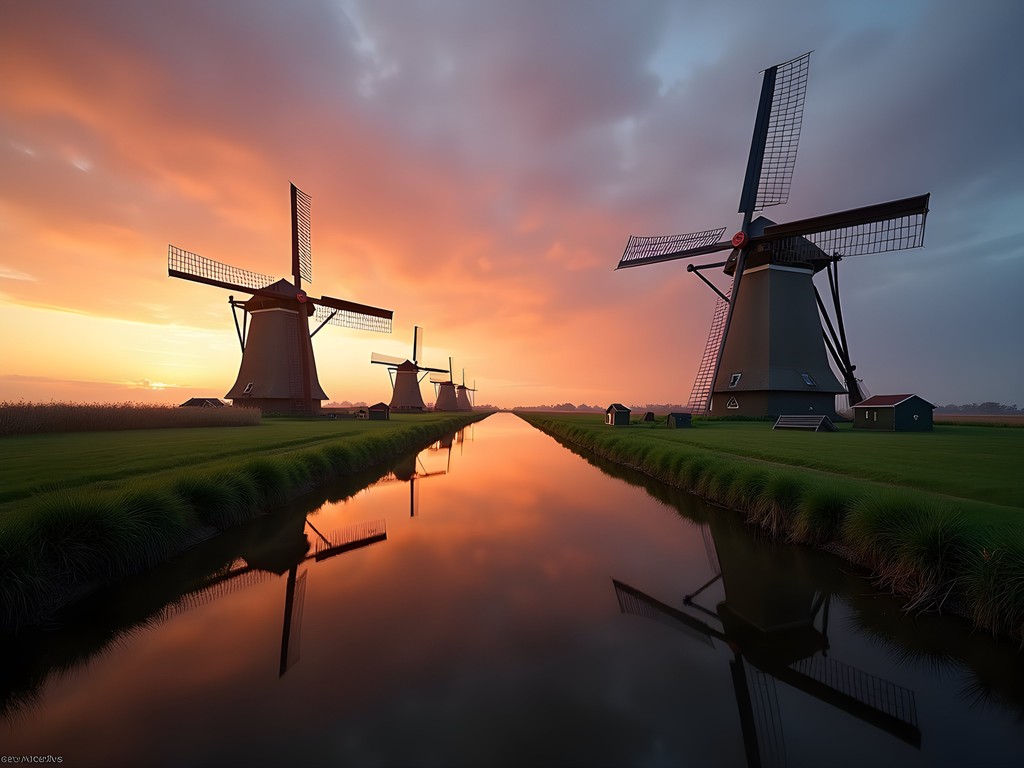
💡 Pro Tips
- Visit on weekdays to avoid weekend crowds in your shots
- Check the weather forecast for fog conditions—they create the most atmospheric images
- Download a sun tracking app to plan your golden hour shots precisely
Best Photography Locations and Angles
After three visits to Kinderdijk, I've mapped out the prime photography locations that offer the most compelling compositions.
The Main Entrance Viewpoint: While seemingly obvious, this spot offers the classic postcard view for good reason. The perspective of multiple windmills receding into the distance creates natural depth. Visit at sunrise when most tourists are still sleeping.
The Northern Canal Path: Walk about 15 minutes along this path for intimate shots of individual windmills with their reflections. The vegetation changes seasonally, with spring bringing vibrant green reeds that frame your shots beautifully.
The Bicycle Bridge: This elevated position provides a unique aerial perspective. I once spent an hour here watching how the rotating windmill blades created different compositional opportunities with each turn.
The Museum Windmill Interior: For something beyond landscape shots, the accessible interior of Nederwaard Museum Mill offers fascinating details of the living quarters. The light streaming through small windows creates dramatic shadows perfect for moody photography.
To capture the full range of perspectives, I rely on my versatile zoom lens which eliminates the need for constant lens changes in this sometimes windy environment. For interior shots where light is limited, my fast prime lens has proven invaluable.

💡 Pro Tips
- Position yourself with the sun at a 45° angle to the windmills for dimensional lighting
- Include cyclists or traditional Dutch boats for scale and cultural context
- Try vertical compositions to emphasize the height of windmills against dramatic skies
Seasonal Photography Opportunities
Each season transforms Kinderdijk into a different photographic canvas. My scientific background has taught me to observe these cyclical changes with appreciation for how they create distinct visual opportunities.
Spring (My Top Recommendation): April through mid-June offers the perfect combination of lush green polders, blooming wildflowers, and active windmills. The quality of light is exceptional—clear and crisp without summer's harsh contrasts. Sunrise happens early (around 5:30-6:00 am), rewarding early risers with magical conditions and few tourists.
Summer: While busier with tourists, summer brings longer days and occasionally dramatic thunderstorms that create spectacular backdrops. The extended blue hour (9:00-10:00 pm) allows for ethereal long-exposure shots with movement in both clouds and windmill sails.
Autumn: By October, morning mist becomes more common, creating otherworldly conditions as the windmills emerge from the fog. Fall colors are subtle here but beautiful—look for golden reeds and the occasional red-leaved tree.
Winter: For the adventurous photographer, winter offers rare opportunities. On the coldest days, canals may freeze, completely transforming your compositions. Snow is uncommon but magical when it happens.
For capturing those fleeting weather conditions, I rely on my weather-sealed camera which has survived everything from Southeast Asian monsoons to Kinderdijk's unpredictable spring showers.
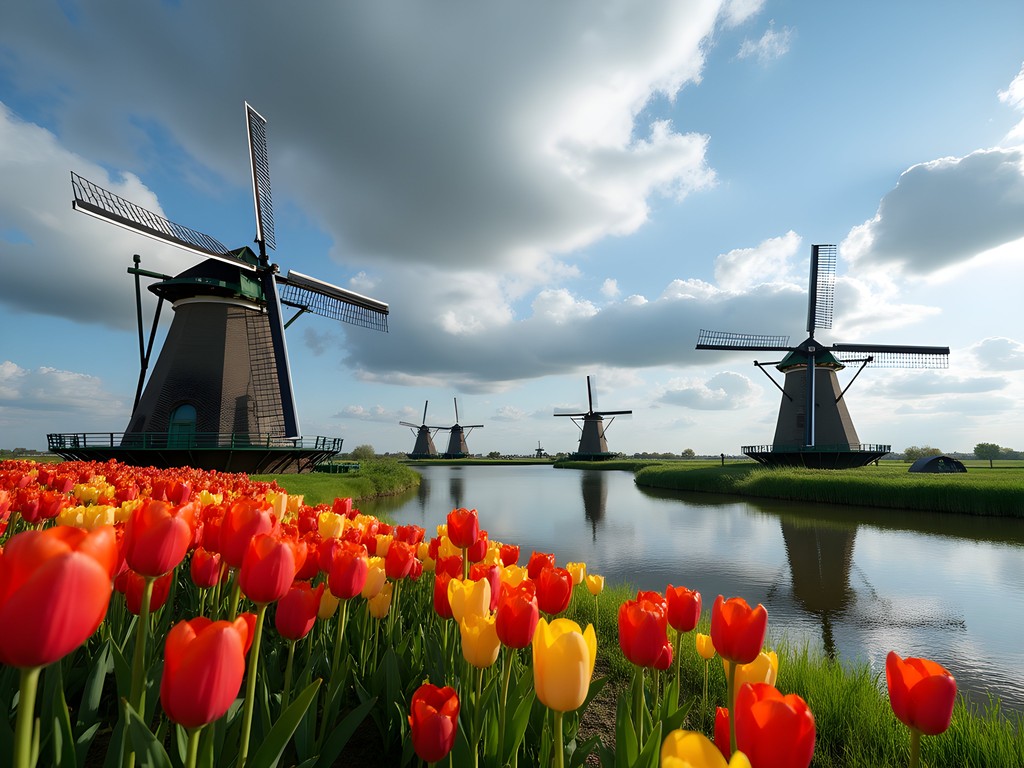
💡 Pro Tips
- Check the windmill rotation schedule—moving sails add dynamic elements to your compositions
- Use a polarizing filter in spring to enhance the vibrant greens and control reflections
- Book accommodation in nearby Dordrecht for easy access to sunrise and sunset shoots
Technical Tips for Windmill Photography
Photographing Kinderdijk presents unique technical challenges that I've learned to overcome through trial and error.
Managing Dynamic Range: The contrast between bright skies and darker windmill structures can exceed your camera's dynamic range. I often bracket my exposures (taking multiple shots at different exposures) and blend them later. Alternatively, a graduated ND filter helps balance exposure in-camera.
Dealing with Wind: Kinderdijk can be surprisingly windy (appropriate for windmills!). For sharp images, increase your shutter speed to at least 1/125s when using telephoto lenses. My camera stabilizer has been invaluable for video work in these conditions.
Capturing Movement: For artistic shots of rotating windmill blades, experiment with slower shutter speeds (1/15s to 1/30s) to introduce a sense of motion while keeping the structure sharp.
Night Photography: Kinderdijk is occasionally illuminated for special events, creating rare night photography opportunities. Bring a remote shutter release and prepare for long exposures (15-30 seconds) on a sturdy tripod.
As a veterinarian who's photographed wildlife in challenging conditions, I've learned that preparation prevents missed opportunities. Always carry spare batteries and memory cards—the remote location means no quick stops at camera shops if something fails.

💡 Pro Tips
- Use apertures between f/8-f/11 for optimal sharpness across your landscape compositions
- Embrace overcast days for soft, even light that reveals texture in the windmill structures
- Consider using HDR techniques for scenes with extreme brightness differences
Cultural Context and Storytelling Through Your Lens
The most compelling Kinderdijk photographs go beyond pretty landscapes to tell the story of Dutch water management and cultural heritage. As someone fascinated by how communities adapt to their environments (whether it's houseboats in Southeast Asia or these ingenious windmills), I try to capture images that reveal this relationship.
The windmills weren't built as tourist attractions but as sophisticated pumping stations to prevent flooding in a country largely below sea level. Look for compositions that show this functionality—the network of canals, the height difference between water levels, the drainage systems.
Include human elements that tell the story of life here: the miller's laundry hanging to dry (yes, some windmills are still inhabited!), traditional wooden boats used by locals, or the ubiquitous bicycles that represent Dutch sustainable transportation.
During my last visit, I had the privilege of speaking with a fifth-generation windmill operator who explained how they read weather patterns to adjust the sail configurations. This conversation completely changed how I photographed the site, focusing more on details that revealed this living heritage.
To document these experiences, I use my audio recorder to capture ambient sounds and interviews that complement my visual storytelling. The gentle creaking of windmill mechanisms and water lapping against canal edges adds another dimension to my presentations back home.
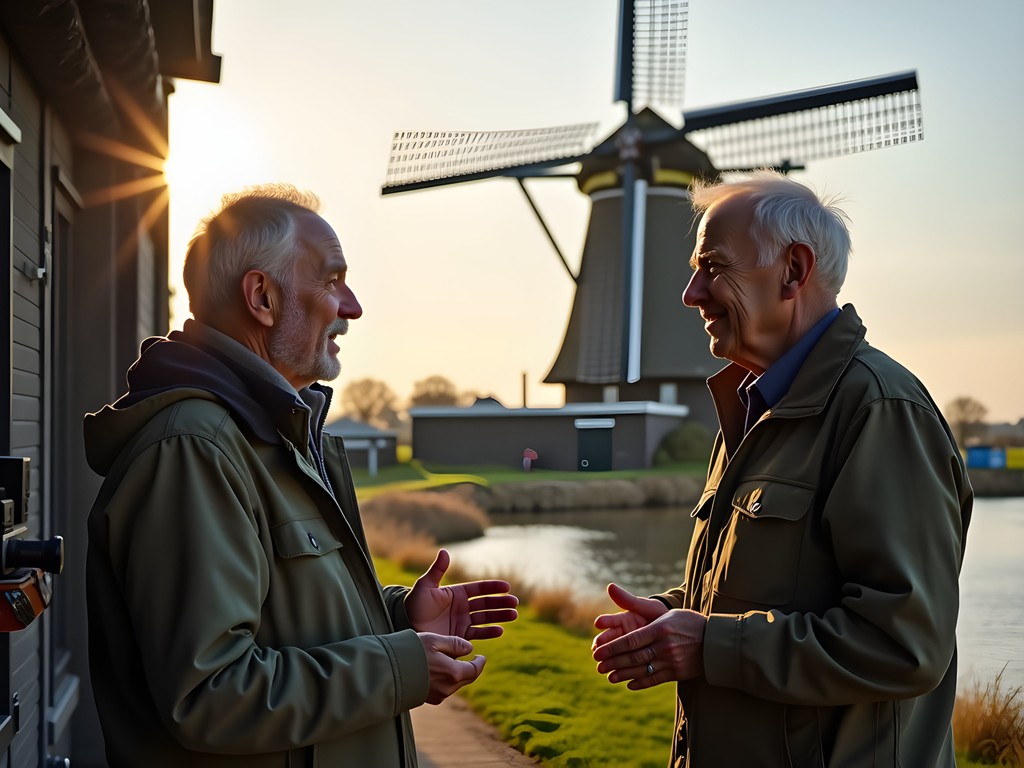
💡 Pro Tips
- Research windmill functions before visiting to better understand what you're photographing
- Capture detail shots of mechanical elements and living quarters to tell a complete story
- Include images of the site's UNESCO information panels to remind yourself of key facts for your photo captions
Final Thoughts
As I packed away my gear after a final sunset shoot at Kinderdijk, watching the windmill sails slowly rotate against the crimson sky, I reflected on how this UNESCO site offers so much more than postcard opportunities. The technical challenges of capturing these historic structures—balancing light, finding fresh compositions, and working with the elements—will push your photography skills in rewarding ways.
But beyond the technical, Kinderdijk offers something increasingly rare in our travels: a chance to connect with centuries of human ingenuity and adaptation. Through your lens, you're not just capturing pretty windmills; you're documenting a living system that has kept Dutch feet dry for generations.
I encourage you to approach Kinderdijk with both technical precision and cultural curiosity. Wake early, stay late, and don't rush. The most compelling images emerge when you take time to observe how light transforms these structures throughout the day and how people continue to interact with this working landscape. Your patience will be rewarded with photographs that tell stories, not just show scenery. I'd love to see what you capture—tag me on Instagram if my guide helps you create something special at this remarkable Dutch treasure.
✨ Key Takeaways
- Plan around golden hours and weather conditions for the most atmospheric shots
- Use reflections, leading lines, and human elements to create compelling compositions
- Understand the cultural and engineering significance to tell a deeper story through your images
- Pack appropriate gear for variable weather conditions and challenging light
📋 Practical Information
Best Time to Visit
Mid-April through early June (spring)
Budget Estimate
$30-50 per day (entrance fee €11, transportation from Rotterdam €15-25)
Recommended Duration
Full day (sunrise to sunset) or weekend for comprehensive coverage
Difficulty Level
Moderate (Early Starts, Potential Weather Challenges)


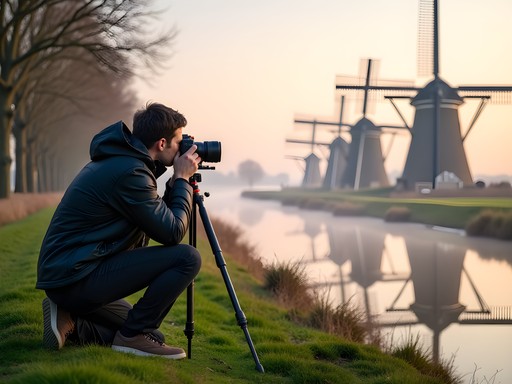
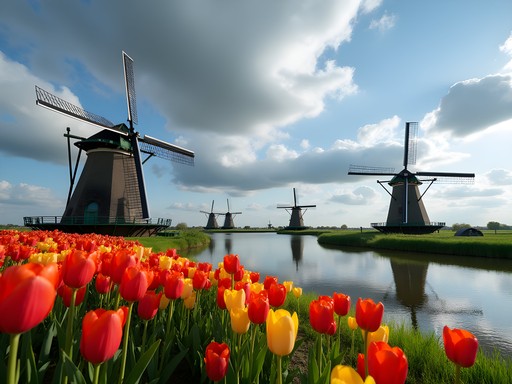
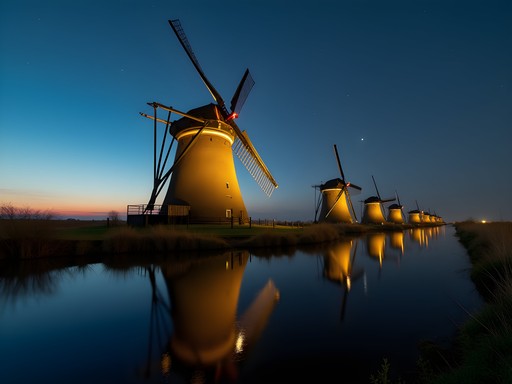
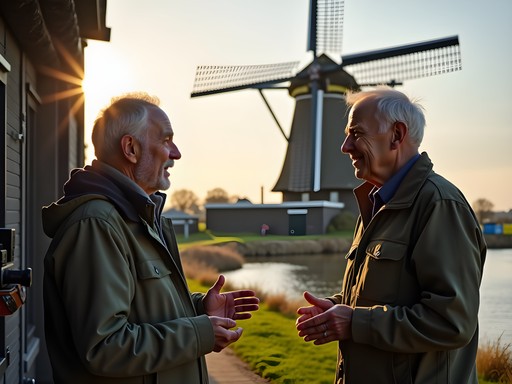


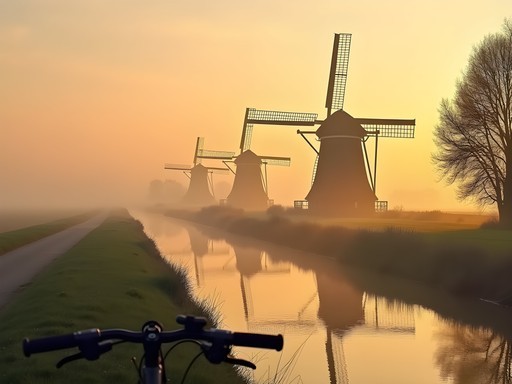







Comments
freequeen
We visited Kinderdijk last spring and your tips about shooting from the far end would have saved us so much time! We spent hours trying to get clean shots without other tourists. Eventually figured out to walk to the furthest windmills first while everyone else clustered near the entrance. The boat tour was actually great for photography too - got some unique angles from the water that weren't possible from the paths. One thing to add: bring something to protect your gear from the surprise rain showers! My camera rain cover was a lifesaver when a sudden downpour hit.
bluelover
Great guide! Planning a trip in October - is that a good time for photography there? Also, are tripods allowed on the walking paths?
redhero
Not OP but I was there last October. Amazing fall colors and yes, tripods are fine as long as you don't block the paths. Early morning is best before the tour buses arrive!
bluelover
Thanks for the info! Definitely planning for early mornings then.
Frank Garcia
Excellent breakdown of the lighting conditions, Casey! I visited Kinderdijk last autumn and found the morning golden hour to be particularly challenging because of the frequent fog. I'd add that photographers should plan at least 2-3 mornings there if possible, as the atmospheric conditions can vary dramatically day to day. The section about composition using the leading lines of the canals was spot on - those reflections can transform an ordinary windmill shot into something truly special. Did you find any particular focal length most versatile there?
Casey Torres
Thanks Frank! I found a 24-70mm covered most situations perfectly. Wide enough for landscapes but with reach for isolating individual windmills. The fog is definitely hit or miss - I got lucky on my third morning!
Frank Garcia
That's exactly what I used! The versatility was perfect there. Glad you got that magical foggy morning on your third try.
moonguy
Those sunrise shots are absolutely stunning! Bucket list location for sure.
nomadguy
Just added Kinderdijk to my Netherlands itinerary because of this post. Those windmills look incredible!
SoloTrekker
That misty morning shot is pure magic! Can't believe how you captured the reflection.
AmsterdamLocal
Pro tip for anyone visiting - check the operation schedule on their website. Some days they run more windmills than others, which makes for better photos!
Casey Torres
That's such good advice! I should have mentioned that in the guide. The National Mill Days in May are especially good for seeing them in action.
moonace
That shot with the windmill reflection in the canal is incredible! How early did you have to wake up for that perfect light?
Casey Torres
Thank you! That was about 30 minutes before sunrise in April - so around 5:45am. Early, but absolutely worth it for the stillness and light!
happyguy
Those misty morning shots are incredible! I'm a total beginner with just my phone camera. Any tips for getting decent shots without fancy equipment? Is it still worth visiting if I'm not a pro photographer?
Casey Torres
Absolutely worth visiting! Modern phone cameras can capture amazing shots at Kinderdijk. Try the panorama mode for wide landscapes, and use HDR mode for those high-contrast sunrise/sunset scenes. The ProRAW setting (if your phone has it) gives you more editing flexibility later. Most importantly, just focus on composition - those windmills are photogenic from any device!
happyguy
That's so encouraging! I was worried my photos wouldn't turn out well. Will definitely try the panorama tip!
islandmood
I just got back from Kinderdijk and used just my phone too! The shots came out great. Make sure to download a basic editing app - I brightened up the shadows a bit and the photos look almost professional.
Jean Wells
Excellent technical breakdown of the lighting challenges at Kinderdijk, Casey. I've photographed there across multiple seasons and would add that a graduated ND filter is invaluable for balancing the bright Dutch sky with the darker landscape, especially during blue hour. The section on shooting locations is spot-on - I'd emphasize point #3 near the museum windmill which many photographers overlook. My tripod was essential for those long exposures capturing the subtle movement of the sails. Your suggestion about visiting on weekdays is crucial advice - weekend crowds can make clean compositions nearly impossible.
Venture X
Premium card with 2X miles, $300 travel credit, Priority Pass